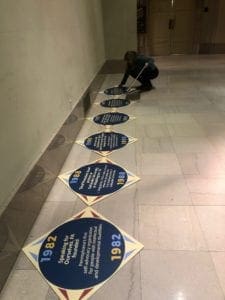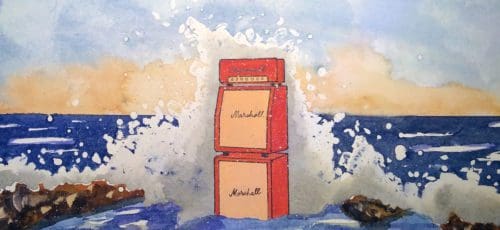Installation and Impact: The Disability History Timeline
In conjunction with our presentation of A Fierce Kind of Love (March 1—3), the Institute on Disabilities’ work that tells the untold story of Pennsylvania’s Intellectual Disability Rights Movement, FringeArts and the Institute have developed two public history timelines that follow the movement for disability rights and self-determination from the turn of the 19th century to today. The first timeline has been installed in the second floor gallery hallway at the Parkway Central Library, and the second one can be found in the East-West corridor of the City Hall courtyard. The project, focused on continuing engagement for the performances of A Fierce Kind of Love in partnership with Disability Equality in Education, displays the largely untold history of this particular civil rights movement to areas of Philadelphia with high foot traffic. The timeline is made up of 24 decals that each recall an imperative moment in the struggle for accessibility and dignity.

In 2016, the Philadelphia Research Initiative reported that 16% of people living in Philadelphia had a cognitive, emotional, or physical disability. That equates to roughly 246,000 people and crowns Philadelphia as having the highest percentage of citizens with disabilities amongst the nation’s top 10 largest cities. For such a large percentage of people, it’s quite surprising that finding information around the city about accessibility, disability history, and disability activism is not exactly an easy feat. A Fierce Kind of Love was created from this disregard and its mission is to draw attention to the lost history of this movement and the overlooked reality of living with disabilities. The Disability History Timeline helps expand on the show’s mission and provides valuable information that draws connections between the movement’s past and its evolution to the present. It was also designed to bridge the gap between the intellectual disability rights movement and the physical disability rights movement which are consistently separated. This design is inclusive among those with any kind of disability and represents all of these folks on an equal spectrum.
On the morning of February 12th, members of FringeArts and the Institute met at the Parkway Central Library to install the timeline. After all of the materials were brought up to the second floor, the team organized all of the decals in chronological order on the floor against the wall. The installation process began by placing the middle decal in the center-point of the wall in order to create an anchor for the timeline out from the center. This first placement was crucial for the visual flow of the timeline, but deciding on the placement of this first decal also made us contemplate how to make the timeline visually accommodating for all. We even enlisted the help of a library security guard who had been watching us prepare for installation to determine at the timeline’s height in order to be seen by everyone, including folks in wheelchairs. With a solid prep-then-adhere system in place for each decal, the timeline was completely installed within the hour. The passersbys who had been curiously watching from afar slowly began to walk down the hallway to take a peek at the finished result. Some came with questions about what the project was for and others walked down the hallway reading through the timeline with a silent curiosity. It was incredible to see the anticipated effect of the timeline come to fruition right before our eyes. People began engaging with us about the project and that quickly developed into conversation about disability rights, accessibility, and more. Most of the inquiring minds expressed how shocked they were that they had no idea that this movement even occurred! It was clear that their interest was sparked by the informative and impactful nature of the project. Each person we spoke to during the installation process graciously thanked us for providing a resource that shines a light on the disability rights movement and promotes a dialogue about it within our community.

The installation in the City Hall courtyard on February 25th required the same precision as the first process, but involved environmental elements that amplified the experience. Although the large gusts of wind exaggerated the bite in the air, we were able to secure the giant sticker decals to the courtyard pavement quickly and efficiently with the help of the City of Philadelphia Office of Arts, Culture and the Creative Economy team members and a variety of tools. We used a device made up of two wood boxes and a string to line up the decals with the compass that marks the center of the courtyard. One box was placed on the very edge of the compass and the other box was placed directly across from it a few feet away causing the string to become taut. The string became our guide for centering the decals and making sure that they were being placed in a straight line. Once the placement was correct, one person pulled off the back of the sticker while two others used their hands to smooth out the decal on the pavement. The last step was using a paint roller to apply pressure across the decal in order to ensure that it was fully adhered to the ground. We repeated this process twenty-three times until completed. This process drew a lot of attention since we were working around mid-day and the courtyard was constantly buzzing with people. Just like the installation process in the library, people began watching us work and asked us questions about the project. Once again, conversations about the disability rights movement flowed naturally. One woman we spoke to even told us about her experience with her son’s intellectual disability and how she hopes more accessible information about disabilities will be on display in the city in the future.

Each timeline will occupy its temporary home for a period of several weeks in order to encourage people to interact with the information before or after going to see A Fierce Kind of Love. In concurrence with the physical presence of the timeline, intergenerational story-sharing events will be held at each timeline location in order to facilitate conversation between students and seasoned self-advocates who took part in the movement. These events will connect students to self-advocates’ stories about the events on the timeline from a first-person perspective and will show younger audience members how they can become their own activists.
The Disability History Timeline will be at the Parkway Central Library from Feb 12-Mar 15 and the East-West corridor of the City Hall Courtyard from Feb 25-end of March. You’ve got plenty of time to check it out either before or after seeing A Fierce Kind of Love!


